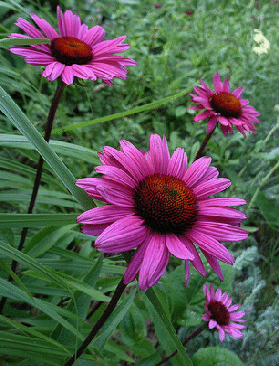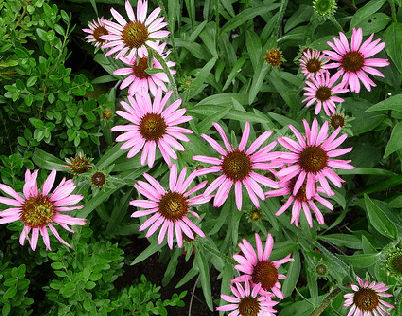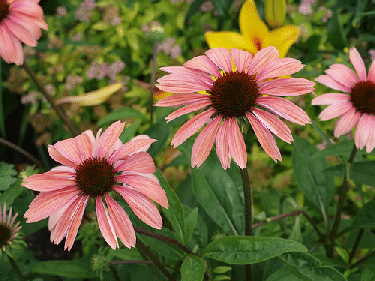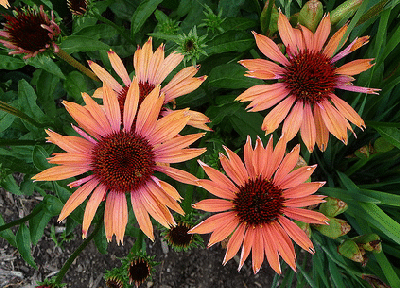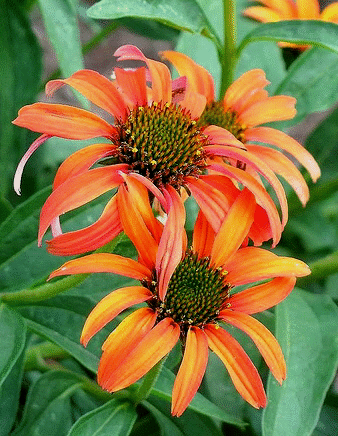Echinacea Coneflower
Echinacea Purple Coneflowers are the easiest perennial and bloom all summer
Purple Coneflowers are one of the easiest perennials to grow and care for. They are heat and drought tolerant, tolerant of poor soil, and are not generally bothered by pests and disease. They make excellent cut and dried flowers, and attract butterflies. Coneflowers are prolific bloomers all season long.
Echinacea, a member of the daisy family, has nine different species commonly called Coneflowers. They are a common prairie flower, but those with the showiest flowers are garden cultivars. Echinacea purpurea, Purple Coneflower, is the most common species used in gardens with many varieties available, as well as hybrids generally crossed with E. purpurea The petals form a cone shape with the outer ray pointing downward and the center forming the cone. The cone is the seedhead. Tall stems bear single blooms that are usually pink to purple, but there are a few white and yellow. The central cone is generally purple to brown in color. Echinacea are very drought tolerant and long living, as well as long blooming, from spring until fall. The hybrids that have been developed since 1997 are even more robust and longer living than the species plant and its cultivars. The hybrids often are sterile or self seed less, and the flowers retain their bright color longer. They are very tolerant of extreme temperatures and humidity, but are not salt tolerant. Echinacea do not require much in the way of fertilizer, apply a slow release balanced fertilizer in early spring if your soil is exceptionally poor. They self seed readily.
Echinacea purpurea
Common Name: Coneflower
Plant Type: Herbaceous perennial
Height: 30-36”
Spread: 16-18”
Sun/Shade Requirements: Full sun
Water Requirements: Low to medium water requirements, about 1-2” per week, do not overwater. Drought tolerant once established.
Soil Requirements: Prefers deeply cultivated, organic, well drained soil. Will tolerate low fertility and clay.
Growth Habit: Upright slowly spreading clumps.
Bloom Time: July through September
Bloom Color: Rose pink with a copper-brown center
Bloom Form: 2-4’ daisy-like flowers with a center cone.
Foliage: Dark green 4-8” lance shaped leaves, becoming smaller toward the top of the stem.
Fragrance: None
Pest and Disease Resistance: Not typically bothered by pests and disease. May be susceptible to leaf spot and Japanese beetles, neither will seriously damage the plant long term.
Fertilize: Apply a slow release 12-6-6 fertilizer in early spring before the leaves emerge.
Maintenance: Stems are strong and do not require staking. Divide in spring or fall every 3 or 4 years to prevent crowding.
Other: Attract butterflies. Deer resistant, but rabbits enjoy the foliage.
Hardiness: Zones 3-8
Once considered a wildflower or native “weed” Echinacea purpurea is now a garden favorite. This is the species plant, not a cultivar, so it retains all the tough and hardy qualities of the native prairie perennial. In the wild, they can live as long as 40 years, in your garden you may want to divide every few to several years to maintain vigor. The petals droop downward as the bloom matures, and the center develops a distinct cone shape. It tolerates poor and dry soils but still produces blooms prolifically. Amending your soil will improve garden performance. Petals curve downward more than the cultivated varieties. Foliage remains fresh through the growing season and are strong and sturdy, holding up well in windy sites. Long sturdy stems make them perfect for cut flowers, remaining fresh in the vase for a long time. Cutting E. purpurea blooms for arrangements and deadheading will encourage reblooming and help prevent self seeding. If you prefer to attract birds, leave the spent blooms to produce seed, which also creates winter interest in your garden.
Echinacea purpurea ‘Magnus’
Common Name: Coneflow er
Plant Type: Herbaceo us perennial
Height: 30-36”
Spread: 12-18”
Sun/Shad e Requirem ents: Full sun to light shade
Water Requirements: Low water requirements after established, do not overwater.
Soil Requirements: Prefers deeply cultivated, organic, well drained soil. Will tolerate low fertility and clay. Not fussy about pH.
Growth Habit: Upright, erect clumps
Bloom Time: June to hard frost.
Bloom Color: Rose pink with a copper-brown center
Bloom Form: 6” daisy-like flowers with a center cone.
Foliage: Dark green lance shaped leaves with stiff hairs, 3-8 inch long leaves.
Fragrance: Lightly fragrant
Pest and Disease Resistance: Not typically bothered by disease or pests, but may be susceptible to leaf spot and Japanese beetles. Neither should do permanent damage to the plant.
Fertilize: Apply a slow release 12-6-6 fertilizer in early spring before the leaves emerge.
Maintenance: Stems are strong and do not require staking. Divide in spring or fall every 3 or 4 years to prevent crowding.
Other: Attract butterflies. Deer resistant, but rabbits enjoy the foliage.
Hardiness: Zones 3-8
‘Magnus’ is considered the “classic” purple coneflower. The petals are held more horizontally than most coneflowers, forming a more flat daisy-like bloom. The pink flowers are large and long lasting. Petals emerge a vivid pink and will mature to a softer shade. As the bloom matures the petals will begin to slightly droop and the center develops a distinct cone shape. In hot regions, half shade will improve the petal color, but the plant will tolerate the hot conditions quite well once established. Water regularly only the first season. Coneflowers grown in too much shade will become weak and produce fewer flowers. Although coneflower will tolerate poor soil, the plant and blooms will be more vigorous if grown in well tilled, amended soil. The foliage remains fresh through the season, forming a sturdy slowly expanding upright clump that is strong enough to hold up in wind Blooming well into fall, until the first hard frost, ‘Magnus’ will be one of the last flowers to succumb to the cold weather. Long sturdy stems are perfect for cut flowers, and the are long lasting in a vase. A prolific bloomer, cutting ‘Magnus’ blooms for arrangements and deadheading will encourage reblooming and help prevent self seeding. If you prefer to attract birds, leave the spent blooms to produce seed, which also creates winter interest in your garden. ‘Magnus’ should not need to be divided. Coneflower are wonderful additions to a perennial border, or naturalize in neglected or difficult to get to areas of the landscape.
Echinacea purpurea ‘Fatal Attraction’
Common Name: Hybrid Coneflower
Plant Type: Herbaceous perennial
Height: 30-36”
Spread: 18-24”
Sun/Shade Requirements: Full sun
Water Requirements: Low water requirements after established, do not overwater.
Soil Requirements: Prefers deeply cultivated, organic, well drained soil. Will tolerate low fertility and clay. Not fussy about pH.
Growth Habit: Upright, erect clumps
Bloom Time: Late June into September, reblooming until frost.
Bloom Color: Vivid magenta pink with a burgundy orange center
Bloom Form: 4” daisy like flowers with a double row of petal and a center button like cone.
Foliage: Bright green, long narrow tapered leaves
Fragrance: Lightly fragrant
Pest and Disease Resistance: Not typically bothered by disease or pests, but may be susceptible to leaf spot and Japanese beetles. Neither should do permanent damage to the plant.
Fertilize: Apply a slow release 12-6-6 fertilizer in early spring before the leaves emerge.
Maintenance: Stems are strong and do not require staking. Divide in spring or fall every 3 or 4 years to prevent crowding.
Other: Attracts butterflies. Deer resistant, but rabbits enjoy the foliage.
Hardiness: Zones 3-8
Slender red black stems hold vivid purple pink blooms with two rows of petals. The full look of the bloom is finished nicely with a button like center that matures to a cone.. Petals are held straight out rather than drooping. ‘Fatal Attraction’ is a striking selection that will shine in your garden. The intense magenta pink color of new blooms will soften as the blooms mature. Strong stems are topped with bright blooms by late June and continuing late into summer, with sporadic reblooming until frost. Deadheading will encourage reblooming and prevent self seeding, seeds will not come up true. Bright green grass like foliage contrasts beautifully with the burgundy stems. ‘Fatal Attraction’ cultivar is tough, hardy and drought tolerant. A stunning perennial for an accent plant, in a border garden or will really spice up a naturalized garden in hot sunny spots. Fabulous cut flower with its’ red black stems.
Echinacea purpurea ‘White Swan’
Common Name: Hybrid Coneflower
Plant Type: Herbaceous perennial
Height: 24-36”
Spread: 18-24”
Sun/Shade Requirements: Full sun
Water Requirements: Low water requirements after established, do not overwater.
Soil Requirements: Prefers deeply cultivated, well drained soil. Will tolerate low fertility. Not fussy about pH.
Growth Habit: Upright, erect clumps
Bloom Time: July to September, reblooming until frost.
Bloom Color: Pure white with a bronze center cone
Bloom Form: 3-4” blooms with deeply reflexed petals and a center button like cone.
Foliage: Bright green, long tapered leaves
Fragrance: Lightly fragrant
Pest and Disease Resistance: Not typically bothered by disease or pests, but may be susceptible to leaf spot and Japanese beetles. Neither should do permanent damage to the plant.
Fertilize: Apply a slow release 12-6-6 fertilizer in early spring before the leaves emerge.
Maintenance: Stems are strong and do not require staking. Divide in spring or fall every 3 or 4 years to prevent crowding.
Other: Attracts butterflies. Deer resistant, but rabbits enjoy the foliage.
Hardiness: Zones 4-8
The creamy white petals of ‘White Swan’ droop downward in the classic coneflower form. The cone starts green then matures to bronze and finally bronze-brown. Fragrance is lightly sweet. As is the case with other white blooming cultivars, ‘White Swan’ is not quite as floriferous as the pink coneflowers, but is nonetheless a long lasting reliable bloomer. Blooms begin to appear in early June and continue as long as September. Deadheading will encourage reblooming, and sporadic blooms may continue until frost. 18” stems are stiff and sturdy, and a perfect vase length for cut flower arrangements. Foliage is a bit lighter and brighter than many coneflowers. This E. purpurea natural cultivar is not quite as cold hardy as some, but is tough and heat and drought tolerant like it’s parent. Zone 3 gardeners have had some success with overwintering, but not if the soil is wet. Enriched soil and added fertilizer is generally unnecessary as long as the soil is moist but well drained, but may enhance performance. ‘White Swan’s’ performance in the garden is bound to please, and is easy to grow and care for. Paired with blooms of bold colors, ‘White Swan’ adds a restful spot to a color packed garden. Planted in groups or drifts makes a beautiful display. ‘White Swan’ grows easily from seed and self seeded plants will come up true to the parent.
Echinacea x ‘Pixie Meadowbrite’
Common Name: Coneflower
Plant Type: Herbaceous perennial
Height: 15-20”
Spread: 20-24”
Sun/Shade Requirements: Full sun
Water Requirements: Low water requirements after established, do not overwater.
Soil Requirements: Prefers deeply cultivated, organic, well drained soil. Will tolerate low fertility and clay. Not fussy about pH.
Growth Habit: Upright, erect clumps
Bloom Time: June to hard frost.
Bloom Color: Pink with a burgundy-orange center
Bloom Form: 3” daisy-like flowers with a center cone.
Foliage: Dark green, rough lance shaped leaves
Fragrance: Lightly fragrant
Pest and Disease Resistance: Not typically bothered by disease or pests, but may be susceptible to leaf spot and Japanese beetles. Neither should do permanent damage to the plant.
Fertilize: Apply a slow release 12-6-6 fertilizer in early spring before the leaves emerge.
Maintenance: Stems are strong and do not require staking. Divide in spring or fall every 3 or 4 years to prevent crowding.
Other: Attracts butterflies. Deer resistant, but rabbits enjoy the foliage.
Hardiness: Zones 4-9
‘Pixie Meadowbrite’ is a hybrid cross between Echinacea purpurea, tennesseensis and angustifolia, resulting in a compact coneflower that produces flat blooms all season long, is tough and vigorous and will live ten years or longer in your garden. It is perhaps the longest living coneflower. The cultivar was originally named CBG Cone 2, and was later renamed ‘Pixie Meadowbrite’ although it is still commonly referred to be the original name. The cultivar is a true dwarf reaching only about 18” tall and spreading 24” wide. The petals are held more flat than the typical coneflower, similar to a daisy bloom. Although all Coneflowers bloom heavily, ‘Pixie Meadowbrite’ is one of the heaviest bloomers, from June to August, then blooms sporadically into fall. Blooming is best in full sun, but in hot regions, part shade will improve petal color. Deadheading spent blooms will encourage reblooming, or leave the flowerheads to attract birds. Seeds that propagate may not come true. The plant is sturdy and well branched, each branch topped with a vibrant bloom, as many as 12-20 per plant. Stems are sturdy enough to hold up in strong winds. Foliage is dense and blue green. This drought tolerant and hardy coneflower may even be hardy in zone 3. The small compact form of ‘Pixie Meadowbrite’ is ideal for smaller gardens, front of the border, tucking in a foundation planting for accent color or in containers.
Echinacea x ‘All That Jazz’
Common Name: Hybrid Coneflower
Plant Type: Herbaceous perennial
Height: 30-36”
Spread: 18-24”
Sun/Shade Requirements: Full sun
Water Requirements: Low water requirements after established, do not overwater.
Soil Requirements: Prefers deeply cultivated, organic, well drained soil. Will tolerate low fertility and clay. Not fussy about pH.
Growth Habit: Upright, erect clumps
Bloom Time: June to August, reblooming until frost.
Bloom Color: Lavender pink with an orange center
Bloom Form: 4” flowers of quilled rays with a center cone.
Foliage: Dark green, large lance to ovoid shaped leaves
Fragrance: Lightly fragrant
Pest and Disease Resistance: Not typically bothered by disease or pests, but may be susceptible to leaf spot and Japanese beetles. Neither should do permanent damage to the plant.
Fertilize: Apply a slow release 12-6-6 fertilizer in early spring before the leaves emerge.
Maintenance: Stems are strong and do not require staking. Divide in spring or fall every 3 or 4 years to prevent crowding.
Other: Attracts butterflies. Deer resistant, but rabbits enjoy the foliage.
Hardiness: Zones 4-8
The petals of ‘All That Jazz’ are very unique. Each petal is rolled to a tube and fluted at the outer edge, reminiscent of ‘Jethro Tull’ coreopsis. The 4 inch blooms of lavender pink have an orange center. ‘All That Jazz’ will rebloom withought deadheading, but removing the spent flower stalks well encourage heavier rebloom. A heavy flush of blooms begins in late spring, lasting through late summer, sporadic blooms will appear right up until frost. Tall flower stalks are very sturdy and do not need staking. The striking and unusual blooms are excellent for fresh or dried arrangements. ‘All That Jazz’ is a large perennial that works well at the back of the border, but the blooms are so interesting a site where they can be appreciated up close would be nice. Use as an accent plant at an entry or in groups or masses along a pathway. The plant is vigorous and adaptable, tolerating drought, heat and humidity as well as poor soil. Plant vigor and blooms will perform best with adequate moisture and organically amended soil. Allow some blooms to remain into winter to attract birds, who love the seeds from the ripened cones. ‘All That Jazz’ will slowly develop into a lovely colony, spreading by underground rhizomes and self seeding.
Echinacea x ‘Firebird’
Common Name: Hybrid Coneflower
Plant Type: Herbaceous perennial
Height: 25-36”
Spread: 18-24”
Sun/Shade Requirements: Full sun
Water Requirements: Low water requirements after established, do not overwater.
Soil Requirements: Prefers deeply cultivated, organic, well drained soil. Will tolerate low fertility and clay. Not fussy about pH.
Growth Habit: Upright, well branched
Bloom Time: Late June into September, reblooming until frost.
Bloom Color: Red orange with red brown center cone
Bloom Form: 3 1/2” blooms with reflexed (drooping) petals surrounding a prominent center cone.
Foliage: 7” long lance shaped dark green leaves.
Fragrance: Lightly fragrant
Pest and Disease Resistance: Not typically bothered by disease or pests, but may be susceptible to leaf spot and Japanese beetles. Neither should do permanent damage to the plant.
Fertilize: Apply a slow release 12-6-6 fertilizer in early spring before the leaves emerge.
Maintenance: Stems are strong and do not require staking. Divide in spring or fall every 3 or 4 years to prevent crowding.
Other: Attracts butterflies. Deer resistant, but rabbits enjoy the foliage.
Hardiness: Zones 4-9
Fire red-orange petals droop down from a very dark red brown center cone, creating a dramatic effect. ‘Firebird’ will definitely get your attention. Green buds open to fire red blooms, the petals slowly age to red orange, and finally matures to orange with red highlights and the petal tips begin to curl. Echinacea all bloom prolifically, but ‘Firebird’ produces blooms even more heavily. The downward sloping petal rays and prominent cone make these blooms look like a badminton birdie. The appearance is often described as shuttlecock-shaped, the classic coneflower bloom. Blooming begins in late spring, continuing into late summer. ‘Firebird’ will rebloom sporadically, deadheading spent flower stalks will encourage reblooming. The plant is well branched and dense with sturdy flower stems. Generally a compact plant of about 25”, many gardeners report mature plants reaching a height of 36” in ideal conditions. Dark green foliage remains fresh through the growing season. Heat and drought tolerant, ‘Firebird’ is perfect in a sunny border or any spot that needs a little pizazz. Excellent as a cut flower.
Echinacea x ‘Hot Papaya’
Common Name: Double Coneflower
Plant Type: Herbaceous perennial
Height: 30-36”
Spread: 24-30”
Sun/Shade Requirements: Full sun
Water Requirements: Low water requirements after established, do not overwater.
Soil Requirements: Prefers deeply cultivated, organic, well drained soil. Will tolerate low fertility and clay. Not fussy about pH.
Growth Habit: Upright, erect clump
Bloom Time: Early July well into September, reblooming until frost.
Bloom Color: Spicy red petals with an orange yellow center cone
Bloom Form: 3 ” double blooms with reflexed (drooping) petals surrounding a prominent center cone.
Foliage: Thick lance shaped, smooth, dark green leaves.
Fragrance: Lightly fragrant
Pest and Disease Resistance: Not typically bothered by disease or pests, but may be susceptible to leaf spot and Japanese beetles. Neither should do permanent damage to the plant.
Fertilize: Apply a slow release 12-6-6 fertilizer in early spring before the leaves emerge.
Maintenance: Stems are strong and do not require staking. Divide in spring or fall every 3 or 4 years to prevent crowding.
Other: Attracts butterflies. Deer resistant, but rabbits enjoy the foliage.
Hardiness: Zones 4-9
‘Hot Papaya’ is stunning. An E. purpurea hybrid double coneflower, the petals form a pom-pom center surrounded by deeply reflexed petals. A papaya colored halo adorns the pom-pom center. Although the coloring alters slightly as the bloom opens and matures, the petals resist fading. A single plant will display as many as ten open blooms at once. Cut flowers will last nearly two weeks. The foliage strongly favors the E. purpurea parentage, forming a strong sturdy clump of deep green leaves and strong maroon marked stems. ‘Hot Papaya’ is very drought tolerant once established. It seems to be well behaved in the garden, spreading slowly to create a lovely colony and self seeding appears limited. The seed will likely not come true to the parent plant. The dried flower heads create attractive winter interest and attracts birds. Find a prominent place for this exciting coneflower, it truly is one of the best.
Echinacea x ‘Katie Saul’ Summer Sky
Common Name: Big Sky Coneflower
Plant Type: Herbaceous perennial
Height: 36-42”
Spread: 18-24”
Sun/Shade Requirements: Full sun
Water Requirements: Low water requirements after established, do not overwater.
Soil Requirements: Prefers deeply cultivated, organic, well drained soil. Will not tolerate wet soil at all. Not fussy about pH.
Growth Habit: Upright, well branched
Bloom Time: Early July well into September, reblooming until frost.
Bloom Color: Hues of orange with a burnt orange center cone
Bloom Form: 5 ” daisy like blooms with wide petals drooping slightly downward surrounding a prominent center cone.
Foliage: Thick toothed dark green leaves.
Fragrance: Lightly fragrant
Pest and Disease Resistance: Not typically bothered by disease or pests, but may be susceptible to leaf spot and Japanese beetles. Neither should do permanent damage to the plant.
Fertilize: Apply a slow release 12-6-6 fertilizer in early spring before the leaves emerge.
Maintenance: Stems are strong and do not require staking. Divide in spring or fall every 3 or 4 years to prevent crowding.
Other: Attracts butterflies. Deer resistant, but rabbits enjoy the foliage.
Hardiness: Zones 4-9
‘Summer Sky’ is one of the Big Sky series of coneflower, they are a hybrid cross between E. purpurea and E. paradoxa (difficult to find yellow coneflower species). ‘Summer Sky’ has large daisy like blooms. Petals are vivid orange that soften toward pink at the petal tips. Cones are a deep burnt brown, which is a perfect center to the summer sky hues of the petals. ‘Summer Sky’ is in theory the most fragrant of the Big Sky series and holds petal color better than the rest. However, even ‘Summer Sky is not color stable nor is it color predictable. Any fragrance is very faint. Flower stems are sturdy and very dark, setting a terrific contrast against the blooms. Deadhead to encourage blooming and to prevent self seeding. The Big Sky Series coneflowers love hot dry conditions and will not tolerate moist soil and humid conditions. Plants overwintered in wet soil will likely not survive. If you have the right conditions, ‘Summer Sky’ may be worth trying.
**A note regarding the Big Sky series: Some gardeners are reporting poor results with most of the series plants. Many of the plants are not surviving the winters even in zones 5, 6 and 7. Petals are irregular and color is not reliable. Many of these same gardeners do also report that they have experienced unusual amounts of rain, humidity, or other unusual weather conditions. Could be the paradoxa heritage causing a problem, they don’t like wet soil at all. The Big Sky series may be a bit more finicky than other species and cultivar coneflowers. If you plant a Big Sky series coneflower, it sounds like it is best to make sure you have ideal conditions, i.e., very well drained organically amended soil and full sun. To be sure, there are more gardeners that have had terrific success with these plants, but it is unusual to hear so very many complaints. At some point you start listening.
Echinacea x ‘Evan Saul’ Sundown
Common Name: Big Sky Coneflower
Plant Type: Herbaceous perennial
Height: 32-36”
Spread: 18-24”
Sun/Shade Requirements: Full sun
Water Requirements: Low water requirements after established, do not overwater.
Soil Requirements: Prefers deeply cultivated, organic, well drained soil. Will not tolerate wet soil at all. Prefers an average to alkaline pH, and may die out in acid soil.
Growth Habit: Upright, well branched
Bloom Time: June well into September, reblooming until frost.
Bloom Color: Salmon orange with a red orange center cone
Bloom Form: 4 ” daisy like blooms with wide petals drooping slightly downward surrounding a prominent center cone.
Foliage: Thick, toothed, large green leaves.
Fragrance: Lightly fragrant
Pest and Disease Resistance: Not typically bothered by disease or pests, but may be susceptible to leaf spot and Japanese beetles. Neither should do permanent damage to the plant.
Fertilize: Apply a slow release 12-6-6 fertilizer in early spring before the leaves emerge.
Maintenance: Stems are strong and do not require staking. Divide in spring or fall every 3 or 4 years to prevent crowding.
Other: Attracts butterflies. Deer resistant, but rabbits enjoy the foliage.
Hardiness: Zones 4-9
‘Sundown’ is one of the Big Sky series of coneflower, they are a hybrid cross between E. purpurea and E. paradoxa (difficult to find yellow coneflower species). ‘Sundown’ has large daisy like blooms. Petals are a salmon-orange, although there are some claims that the petals are intense orange. If so, it would be nice to know the exact growing conditions that produce the intense orange, because generally they are a warm russet to salmon color. Petals will fade to a light pink as the bloom matures Cones are brown with hints of red and orange, which complements hues of the petals. Blooming begins in early summer and continues well into fall. Cut flowers will last up to 12 days in a vase. ‘Sundown is taller than ‘Sunset’ but with smaller blooms. ‘Sundown’ also seems a bit more vigorous than ‘Sunset’. ‘Sundown’ is supposed to have a great scent, reminiscent of roses, however gardeners report that there is little if any fragrance. Flower stems are very sturdy and the plant is compact but well branched, a vigorous grower. Deadhead to encourage blooming and to prevent self seeding. Seeds that produce will not come up true to the parent. The Big Sky Series coneflowers love hot dry conditions and will not tolerate moist soil and humid conditions. Plants overwintered in wet soil will likely not survive. If you have the right conditions, ‘Sundown’ may be worth trying. ‘Sunset’ has been discontinued by many growers and replaced with ‘Sundown’, which is supposed to be more stable in color with more consistent bloom form. ‘Sundown’ still has some of these problems, and may be replaced again in the future with another improved hybrid.
**see above note regarding the Big Sky Series
Echinacea x Sunrise
Common Name: Big Sky Coneflower
Plant Type: Herbaceous perennial
Height: 30-36”
Spread: 18-24”
Sun/Shade Requirements: Full sun
Water Requirements: Low water requirements after established, do not overwater.
Soil Requirements: Prefers deeply cultivated, organic, well drained soil. Will not tolerate wet soil at all. Prefers an average to alkaline pH, and may die out in acid soil.
Growth Habit: Upright, well branched
Bloom Time: June well into September, reblooming until frost.
Bloom Color: Soft yellow with a golden orange center cone
Bloom Form: 4-5” daisy like blooms with wide petals drooping slightly downward surrounding a prominent center cone.
Foliage: Thick, toothed, large green leaves.
Fragrance: Lightly fragrant
Pest and Disease Resistance: Not typically bothered by disease or pests, but may be susceptible to leaf spot and Japanese beetles. Neither should do permanent damage to the plant.
Fertilize: Apply a slow release 12-6-6 fertilizer in early spring before the leaves emerge.
Maintenance: Stems are strong and do not require staking. Divide in spring or fall every 3 or 4 years to prevent crowding.
Other: Attracts butterflies. Deer resistant, but rabbits enjoy the foliage.
Hardiness: Zones 4-9
‘Sunrise’ is one of the Big Sky series of coneflower, they are a hybrid cross between E. purpurea and E. paradoxa (difficult to find yellow coneflower species). ‘Sunrise’ has large daisy like blooms with slightly reflexed petals. Petals are a butter yellow with a golden center cone that starts out green. The petals fade to a creamy yellow as the blooms mature. Blooming begins in early summer and continues well into fall. Cut flowers will last up to 12 days in a vase. Flower stems are very sturdy and the plant is compact but well branched, a vigorous grower. Deadhead to encourage blooming and to prevent self seeding. Seeds that produce will not come up true to the parent. The Big Sky Series coneflowers love hot dry conditions and will not tolerate moist soil and humid conditions. Plants overwintered in wet soil will likely not survive. ‘Sunrise’ petal form is generally not stable. Petals may be flat or reflexed, broad or tubular, single or overlapped. These variations may occur all on the same plant, as seen in the photo above. If you have the right conditions, ‘Sunrise’ may be worth trying.
**see above note regarding the Big Sky Series
Echinacea x ‘Tomato Soup’
Common Name: Hybrid Coneflower
Plant Type: Herbaceous perennial
Height: 30-36”
Spread: 18-24”
Sun/Shade Requirements: Full sun
Water Requirements: Low water requirements after established, do not overwater.
Soil Requirements: Prefers deeply cultivated, organic, sandy, well drained soil. Will tolerate low fertility. Not fussy about pH.
Growth Habit: Upright, well branched
Bloom Time: Late June into September, reblooming until frost.
Bloom Color: Scarlet red with red brown center cone
Bloom Form: 4-5” blooms with slighty reflexed (drooping) petals surrounding a prominent center cone.
Foliage: 7” long lance shaped dark green leaves.
Fragrance: Lightly spicy fragrance
Pest and Disease Resistance: Not typically bothered by disease or pests, but may be susceptible to leaf spot and Japanese beetles. Neither should do permanent damage to the plant.
Fertilize: Apply a slow release 12-6-6 fertilizer in early spring before the leaves emerge.
Maintenance: Stems are strong and do not require staking. Divide in spring or fall every 3 or 4 years to prevent crowding.
Other: Attracts butterflies. Deer resistant, but rabbits enjoy the foliage.
Hardiness: Zones 4-9
Bright tomato red blooms make ‘Tomato Soup’ one of the best red coneflowers. Introduced in 2009, it has become wildly popular quickly, with growers quickly selling out of stock each spring. There are claims of 5 and even 6” huge blooms, but 4” is probably more realistic. To produce the huge blooms, plant in organically enriched soil that is moist but very well drained in site protected from wind. In cooler climates full sun will produce the best results, but in hot regions some afternoon shade will help the petals retain color longer. The blooms will fade, sometimes quite quickly, eventually reaching a pink or even cream color. Blooming is prolific through summer and will usually rebloom until frost without deadheading. As a cut flower the blooms can last as long as 12 days. The stems are strong and the plant is well branched. ‘Tomato Soup’ is a hybrid cross between E. paradoxa and E. purupurea ‘Ruby Giant’. It is heat drought and heat tolerant, likes full sun but afternoon shade will help retain petal color in all regions. ‘Tomato Soup’ may be a bit slow getting established the first year, but seems to be vigorous and reliable. It has performed consistently well in Midwest zone 4 gardens.



